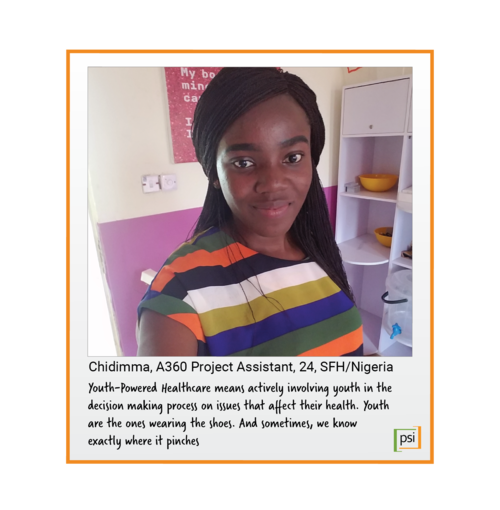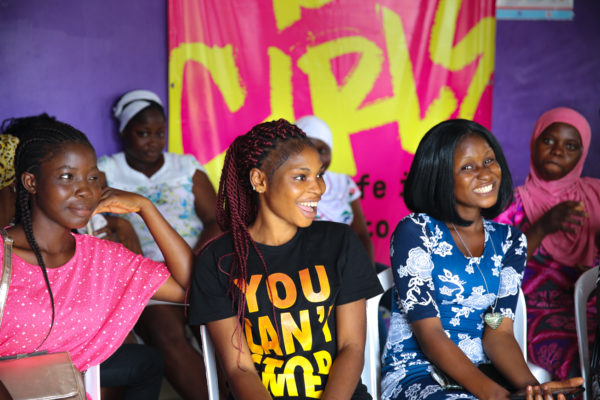We asked young visionaries from A360 and across the PSI network to share what youth-powered healthcare means to them. You can view their answers here.
Then, we asked PSI and A360’s Senior Adolescent and Youth Sexual and Reproductive Health Technical Advisor What Youth-Powered Healthcare means to her. Here’s what she said:
WHAT DOES YOUTH-POWERED HEALTHCARE MEAN TO ME?
Well, as a 41-year old white woman living in Washington, D.C it means that you probably should not be asking me.
At least, not first.
As PSI’s Senior Adolescent and Youth Sexual and Reproductive Health (AYSRH) Technical Advisor, I am charged with outlining where we, as an organization, can drive forward our commitment to the youth we work with and for. At PSI, we’ve pledged to reach 10 million young people with modern contraception by 2020. It’s all part of PSI’s shift and strategic plan to revolutionize how adolescents and youth access the widest range of contraceptive choices from who they want, where they want and how they want.
I see Youth-Powered Healthcare as a recognition of two things: firstly, all programs, in this era, are youth programs; and secondly, young people must be a part of, if not drive, the decisions that impact their health and well-being.
EVOLVING THE NARRATIVE
With more than 1.8 billion youth aged 10-24 globally, young people comprise over a quarter of the global population. Nearly 90 percent of those live in low and middle-income countries. In fact, youth make up between 40 to 75 percent of individual country populations. The trends will continue. Young people are and will remain our health consumers.
The demographic requirements to focus on adolescents are undeniable. The word is spreading, global commitments are being made, and donors are calling.
But a focus on youth and adolescents in global health is not a new phenomenon. Over the years, the HIV community has ping-ponged from ill-conceived abstinence-only programs to products designed to “attract young people,” like studded, colored or flavored condoms. The reproductive health field has deployed countless marketing campaigns, edutainment events, life-skills programs and unfortunately, ineffective youth centers and peer education programs. Yet, unmet need for this group remains high and adolescent birth rates continue to rise. What are we doing wrong?
We’re working with the wrong people and we’re asking the wrong questions.
We need to evolve the narrative not only on who we are serving but more importantly, how we are serving.
LET’S STOP YOUTH-SPLAINING
Up until now, ours has been an “adult world.” Seniority and status are linked to higher age brackets and as a result, those individuals are our decision-makers. Yet, the increasing number of young people across the planet could fundamentally change the face of humanity. I wonder: what will a “young world” look like? With younger people taking office, leading companies, inventing, creating, and advocating for their own rights, it is foolish to think that the way that we work won’t also change.
As a global health community, we’ve been “youth-splaining,” in what has truly been an ageist approach. We create programs that we think young people want and will respond to. We begin with the problem, rather than the solution.
For example, we’ve learned that the term ‘family planning’ often does not resonate with young people, however we continue to use biased terminology to define young people as ‘sexually active’— a term that also does not resonate with adolescents and youth. Research shows that most adolescent sex is infrequent, unplanned, and often forced or coerced. Furthermore, young people can very quickly move from never having been, to being fully sexually active.
But as Adolescents 360’s Blueprint for Change details, we can divorce contraception from sexual activity so that youth realize contraception as a tool they need to achieve their immediate and future goals today, regardless of their sexual behavior. Instead, we can leverage girls’ insights to reframe contraception as a way to protect fertility for when girls are ready.
For PSI’s flagship AYSRH project Adolescents 360 (A360), that meant respecting girls’ expressed desires for motherhood as their primary join and to begin our counseling messaging with return to fertility rather than length of method effectiveness.We’ve doubled down on our efforts to consistently address questions about side effects during and after the services through follow-up. And we’re working to get care into young people’s hands by focusing on direct-to-consumer options including self-administration while also maintaining high quality youth-friendliness among our private providers and across the healthcare continuum. Our goal is to offer affordable, accessible services for youth, by youth and with youth.
There is no doubt that brands matter to young people. In Tanzania, A360’s Kuwa Mjanja program is a girl-driven brand created by girls for girls. It redefines an old proverb of “Being Smart” from fear-based “stay away from boys” to power-based “I’m a girl with a plan.” Brands can build trust and credibility if they are matched to youth-powered solutions that maintain high quality.
FROM YOUTH-FOCUSED TO YOUTH-POWERED
PSI recognizes these winds of change and has been generating a groundswell of support for youth leadership in the ways that we design, implement, evaluate and even fund programming for young people. We know that what got us here will not get us to where we need to be. We have got to reimagine healthcare in a way that speaks to a new world. A young world.
By segmenting the young people we serve, we’re respecting young people’s unique experiences and needs depending on issues such as geography, economic status, marriage & parity status, age, cognitive & social development and fertility intention.
We’re offering young people the right to be co-designers of the programs created for them using human-centered design and we’re hiring them on our staff. Young people take us down roads we had not previously considered, and often away from health as the primary driver. Our job as true adult partners is to find ways that contraception fits to their needs and priorities, including job skills, financial planning or community action. Young people are on our staff, implementing, collecting data, evaluating provider accountability, and more. We’re even supporting a new generation of young entrepreneurs through PSI’s Maverick Next aimed specifically at funding AYSRH programming.
From Tanzania to Nigeria and Ethiopia, we’re designing differently and relearning what we thought we knew. Together, we are rebalancing the scales of power; we’re respecting the intrinsic skills that young people already have and we’re elevating those into our work.
We understand: healthcare that puts young girls and boys at the center is not enough. We know that working for young people is not nearly as effective as working alongside them. Young people need to be key participants in the decisions that affect their lives and their communities.
That’s what Youth-Powered Healthcare means to me.
— Amy Uccello, Senior Adolescent and Youth Sexual and Reproductive Health Technical Advisor, PSI






